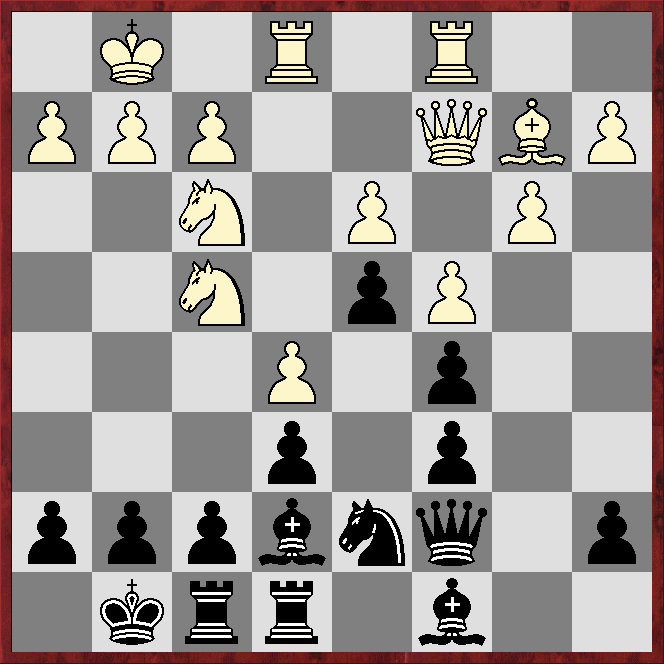Spanton (1937) - Lothar Eichenberger (1739)
Sicilian Bb5(+)
1.e4 c5 2.Nf3 Nc6 3.Bb5 e6 4.Bxc6!?
This continuation is second in popularity in ChessBase's 2025 Mega database, a long way behind 4.0-0.
4...bxc6 5.d3 Rb8!?
The main line in Mega25 runs 5...Ne7 6.Qe2 Ng6 7.h4!? h5 8.e5!? f6!? 9.Qe4 Kf7!?, when Stockfish17 and Dragon1 reckon White is slightly better.
6.b3 Nf6!?
The engines do not like this, preferring 6...Rb7!? (Stockfish17) or 6...d6 (Dragon1).
*****
*****
*****
*****
7.Bb2
Stockfish17 suggests 7.e5 Nd5 8.c4!?, but Dragon1 varies with 8.0-0.
7...d5 8.Nbd2 Ba6 9.c4 Be7 10.0-0 0-0
*****
*****
*****
*****
Black has the bishop-pair, but neither bishop has much scope. White has the superior pawn-structure, and has achieved one of the main aims of the 4.Bxc6!? variation, namely to keep Black's light-square bishop locked away on the queenside, unable to give much, if any, help against a white kingside attack. The engines give White the upper hand.
11.Qc2
The engines prefer 11.Ne5, 11.Rel or 11`.Qe2!?
11...Bb7!?
This is Dragon1's top choice for a short while. It looks strange moving the bishop to a diagonal that is no more likely to open than the one it is already on, but from b7 the bishop gives extra support to the d5 pawn - support that might be needed if White manoeuvres to be in position to initiate central captures designed to pressure c5 and/or e7.
12.Rac1 Rbc8 13.Rfe1 Nd7 14.Nf1 d4?!
This would be fine - good even - if Black could follow up with ...e5, but White can prevent that. The engines agree 14...f6 is best, but disagree as to how White should meet it. If 15.e5, then 15...f5 leaves the centre closed, but gains kingside space. Stockfish17 suggests 15.h4!?, and if 15...e5 then 16.h5 or 16.Ng3, intending 17.Nf5. An improvement might be 15.Qe2. Dragon1 suggests15.exd5 cxd5!? 16.Rxe6, but Black seems to have decent compensation for a pawn as the position is opening up for the bishops. All in all, a strategically tricky position.
15.e5 Qc7
If 15...f6 (or 15...f5) then 16.exf6 Rxf6 leaves White with a pleasant choice between 17.Re4 and 17.Ng3 (other moves are also probably good).
16.Ng3 Rce8 17.Nh5 Bc8 18.Nf4?
Best is probably 18.Qd2!?, eg 18...f6 19.Re4!? Nxe5 20.Nxe5 fxe5, when, for a pawn, White gets good kingside play.
*****
*****
*****
*****
18...g6?
This is simply weakening, whereas 18...g5!? 19.Nh5 g4 20.Qd2 Kh8 (forced) 21.Ng5 Nxe5 seems to safely win a pawn, albeit Black's king looks a little exposed.
19.Qe2 Kg7?!
This is arguably consistent, but almost certainly better is 19...Bd8!?, preparing ...f6.
20.Ra1
Clearing c1 for the bishop.
20...Rh8?!
Central counterplay, via ...Bd8 and ...f6, was urgent.
21.h4 Reg8 22.Bc1 Qd8 23.Qe4 Bb7
The engines suggest 23...h6!?, reckoning 24.Qxc6 Qb6 25.Qxb6 axb6 gives Black more than enough for a pawn. However White does not have to grab the doubled pawn, eg 24.g3 Kf8 25.Kf1 Bb7 26.Bd2, with further manoeuvring to come, looks pleasant for White.
24.Ng5
Threatening to double-capture on e6.
24...Nf8
Possibly better is 24...Bxg5 25.hxg5, as long as Black does not lose the queen to 25...Qxg5? 26.Nxe6+! etc.
25.Qf3 Bxg5?!
Better, but still losing, is 25...Qe8, although after 26.Ne4 Black's pieces on the kingside are numerous but curiously helpless.
26.hxg5
Even stronger is 26.Nh5+! gxh5 27.Bxg5.
26...h6
There is no good answer to the threat of 27...Qh3-h6+, or the even bigger threat of 27...Nh5+!? 28.gxh5 Qxh5.
27.Nh3 h5?
Better is 27...Nh7, but 28.gxh6+ leaves White the equivalent of almost a rook ahead, according to the engines.
28.Qf6+ Kh7
Or 28...Qxf6 29.gxf6 Kh7 30.Ng5+ Kh6 31.Nxf7+ Kh7 32.Ng5+ Kh6 33.f7 etc.
29.Qxd8 1-0



No comments:
Post a Comment